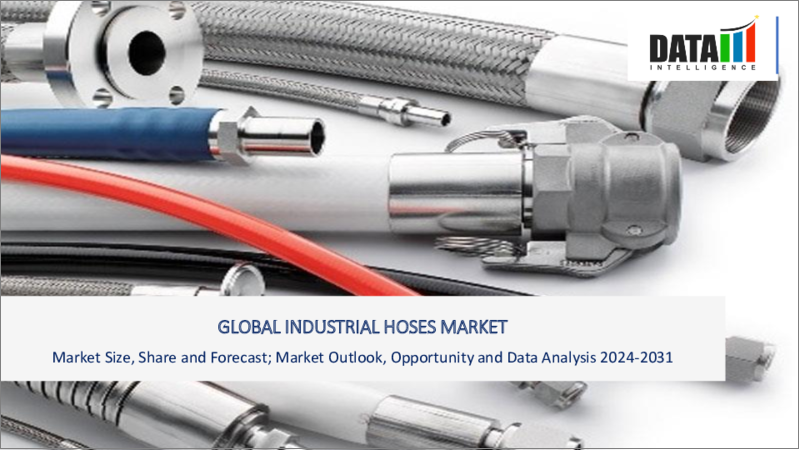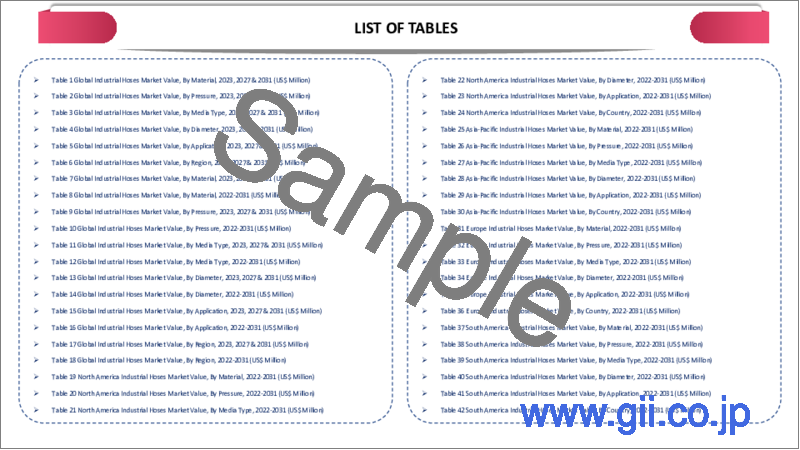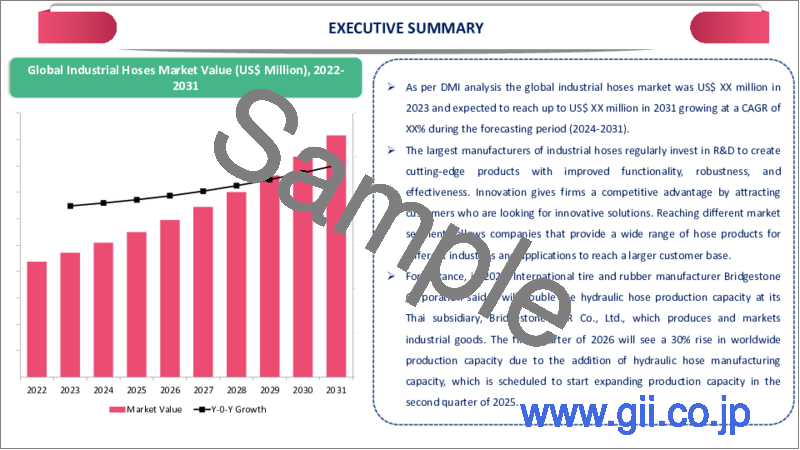|
|
市場調査レポート
商品コード
1336681
産業用ホースの世界市場-2023年~2030年Global Industrial Hoses Market - 2023-2030 |
||||||
カスタマイズ可能
適宜更新あり
|
|||||||
| 産業用ホースの世界市場-2023年~2030年 |
|
出版日: 2023年08月22日
発行: DataM Intelligence
ページ情報: 英文 202 Pages
納期: 即日から翌営業日
|
- 全表示
- 概要
- 目次
市場概要
産業用ホースの世界市場は、2022年に132億米ドルに達し、2023-2030年の予測期間中にCAGR 6.1%で成長し、2030年には221億米ドルに達すると予測されています。継続的に成長しているインフラ関連活動が、主に世界の産業用ホース市場を牽引しています。インフラ関連プロジェクトの増加は、インフラへの民間参加(PPI)の資金投入を促し、ホース需要の増加をもたらしています。
国連によると、世界の人口は2050年までに約98億人に達すると予測されており、都市部に住む人の数は農村部の2倍以上になるため、建設部門の拡大が見込まれています。建築・建設は、予測期間中、世界の産業用ホース市場の約1/3を占めると予測されています。産業用ホースは、流体、固体、気体の移送を伴う様々な用途に不可欠です。
市場力学
主要企業による市場戦略の採用拡大
市場リーチ、流通網、顧客サービス能力を拡大するため、大手企業は他社、流通業者、サプライヤーとの戦略的提携や協力関係を構築する可能性があります。市場での地位を固め、新技術を獲得し、補完的な製品ラインへのアクセスを得るために、大手企業は戦略的買収や合併を行っています。
市場リーダーは、大きな成長の可能性を秘めた新たな地域や新興市場への進出に資金を投じることができます。これは、新たな顧客基盤や潜在顧客へのアクセスを獲得するのに役立ちます。産業用油圧ホース、継手、カップリングの設計、製造、販売を専門とするRyco Hydraulics社は、新しいオフィスと倉庫施設を完成させ、2020年1月に本社をオーストラリアのビクトリア州デリマットに移転しました。
自動車産業からの需要の高まり
自動車産業で使用される産業用ホースは、用途にもよるが、ゴム、シリコン、熱可塑性プラスチックなどの素材で構成されることが多いです。エンジンの極端な温度、流体への暴露、機械的ストレスに耐えられるように作られています。エンジンの温度を管理し、オーバーヒートを避けるために、自動車エンジンには冷却システムが必要です。クーラントホースは、エンジン、ラジエーター、クーラントリザーバー間でクーラントを循環させるために使用されます。通常、ゴム製かシリコン製です。
油圧ブレーキホースは、すべての車両のブレーキシステムの重要な部分です。ブレーキフルードをマスターシリンダーからブレーキキャリパーまたはホイールシリンダーに送り、 促進要因がブレーキペダルを踏んだときにブレーキをかけることができるようにします。カーエアコンや暖房システムでは、冷媒、高温の冷却水、調整された空気を車内全体に運ぶために産業用ホースが使用されています。
技術的課題
高温や腐食性物質のような過酷な条件に耐えるホースを開発するのは難しいです。材料科学や製造技術の進歩に対応するためには、継続的な投資が必要です。石油・ガスなど特定の産業に過度に依存すると、その分野の市場低迷に企業がさらされる可能性があります。
技術要件が多様化するため、新規市場への多様化が困難な場合もあります。産業用ホース市場には幅広い用途があり、それぞれ独自のホース仕様があります。メーカーにとって、幅広い製品群を管理することは複雑でコストがかかる可能性があります。技術革新のスピードが速いため、ホースのタイプや素材によっては陳腐化し、製品ライフサイクルが制限される可能性があります。
COVID-19影響分析
製造工場における労働力不足は、施錠、社会的遠ざけ措置、その他のパンデミック関連の制限によって引き起こされます。製造能力や納期にもさらなる影響を及ぼします。様々な政府がパンデミック期間中に輸出入制限を課し、国際貿易に影響を与えました。産業用ホースと関連製品の世界の流れに損害を与えました。
パンデミックによる全般的な経済不安は、産業界全体で投資の減少とプロジェクトの遅延をもたらしました。これは、特に建築・インフラプロジェクトにおけるホース需要に間接的な影響を与えました。ホース価格は、サプライチェーンの中断と需要パターンの変化が入り混じった影響を受けた。品薄のために価格が上昇する場面もあれば、需要の減少によって価格が下落する場面もあります。
ロシア・ウクライナ戦争の影響
ウクライナ侵攻のような事態は、石油・ガス価格の上昇により、カーボンブラックや樹脂などの原料価格を引き上げる可能性があります。エネルギー・コストの上昇は、ホース・メーカーの価格制限を悪化させるだけです。樹脂は石油由来であるため、ロシア・ウクライナ紛争によるサプライチェーンの中断の影響を受けると思われます。
熱可塑性油圧ホースはカーボンブラックではなく樹脂で構成されているため、この脆弱なサプライチェーンではゴム製油圧ホースの強力なライバルとなります。紛争は地政学的な不確実性を引き起こし、投資家心理の低下と経済的不安定をもたらしました。これは、建設、製造、石油・ガスといった業界の産業用ホース需要に影響を及ぼしています。
目次
第1章 調査手法と調査範囲
第2章 定義と概要
第3章 エグゼクティブサマリー
第4章 市場力学
- 影響要因
- 促進要因
- 主要企業による市場戦略の採用拡大
- 自動車産業からの需要の高まり
- 抑制要因
- 価格変動と厳しい規制
- 技術的課題
- 機会
- 影響分析
- 促進要因
第5章 産業分析
- ポーターのファイブフォース分析
- サプライチェーン分析
- 価格分析
- 規制分析
第6章 COVID-19分析
第7章 材料別
- ゴム
- ポリウレタン
- ポリ塩化ビニル
- シリコーン
- その他
第8章 圧力別
- 産業用低圧ホース
- 産業用中圧ホース
- 産業用高圧ホース
第9章 用途別
- 建築・建設
- 工業・製造業
- 医薬品
- 自動車
- 石油・ガス
- 化学
- 農業
- その他
第10章 地域別
- 北米
- 米国
- カナダ
- メキシコ
- 欧州
- ドイツ
- 英国
- フランス
- イタリア
- ロシア
- その他欧州
- 南米
- ブラジル
- アルゼンチン
- その他南米
- アジア太平洋
- 中国
- インド
- 日本
- オーストラリア
- その他アジア太平洋
- 中東・アフリカ
第11章 競合情勢
- 競合シナリオ
- 市況/シェア分析
- M&A分析
第12章 企業プロファイル
- Eaton Corporation PLC
- 会社概要
- 製品ポートフォリオと説明
- 財務概要
- 最近の動向
- Continental AG
- Transfer Oil S.p.A.
- United Flexible
- Semperit AG Holding
- Campbell Fittings Inc
- Parker-Hannifin Corporation
- Ryco Hydraulics
- Polyhouse India Pvt Ltd
- Gates Industrial Corporation PLC
第13章 付録
Market Overview
Global Industrial Hoses Market reached US$ 13.2 billion in 2022 and is expected to reach US$ 22.1 billion by 2030, growing with a CAGR of 6.1% during the forecast period 2023-2030. The continually growing infrastructure-related activities are primarily driving the global industrial hoses market. The growing number of infrastructure-related projects encourages private participation in infrastructure (PPI) to invest more money, resulting in increased demand for hoses.
According to the United Nations, the worldwide population is predicted to reach roughly 9.8 billion by 2050, with more than twice as many people living in urban areas as in rural regions, increasing the expansion of the construction sector. Building and construction are estimated to account for around 1/3rd of the global industrial hoses market during the forecast period. Industrial hoses are essential in a variety of applications that involve the transfer of fluids, solids and air.
Market Dynamics
The Growing Adoption of Market Strategies by Major Players
To expand their market reach, distribution network and customer service capabilities, major firms may develop strategic partnerships or collaborations with other companies, distributors or suppliers. Strategic acquisitions or mergers are being made by major players in order to consolidate their market position, acquire new technology or get access to complementary product lines.
Market leaders can spend in expanding into new geographic regions or emerging markets with significant growth potential. It can assist them in gaining access to new customer bases and potential customers. Ryco Hydraulics, a firm that specializes in the design, manufacture and distribution of hydraulic Industrial Hoses, fittings and couplings, completed a new office and warehouse facility and relocated the company's headquarters to Derrimut, Victoria, Australia, in January 2020.
The Rising Demand from Automotive Industry
Depending on the application, industrial hoses used in the automotive sector are often comprised of materials such as rubber, silicone or thermoplastic. It is built to endure the engine's extreme temperatures, fluid exposure and mechanical stress. To manage engine temperature and avoid overheating, automotive engines need a cooling system. Coolant hoses are used to circulate coolant between the engine, radiator and coolant reservoir. It is usually made of rubber or silicone.
Hydraulic brake hoses are an important part of every vehicle's braking system. It transfers braking fluid from the master cylinder to the brake calipers or wheel cylinders, allowing the driver to apply the brakes when he or she pushes the brake pedal. In car air conditioning and heating systems, industrial hoses are used to transport refrigerant, hot coolant and conditioned air throughout the vehicle cabin.
Technological Challenges
It can be difficult to develop hoses that can endure harsh conditions like as high temperatures and corrosive substances. Keeping pace with advances in material sciences and manufacturing technology necessitates ongoing investment. Excessive reliance on specific industries, such as oil and gas, can expose enterprises to market downturns in those sectors.
Diversification into new markets may be difficult due to diverse technical requirements. The industrial hoses market includes a wide range of applications, each with its own set of hose specifications. For manufacturers, managing a wide product range may be complicated and costly. Due to the rapid rate of technological innovation, some hose types or materials may become obsolete, resulting in a limited product lifecycle.
COVID-19 Impact Analysis
Labor shortages in manufacturing plants were caused by lockdowns, social distancing measures and other pandemic-related restrictions. It has a further influence on manufacturing capacity and delivery timelines. Various governments imposed export and import restrictions during the pandemic, affecting international trade. It caused damage on the global flow of industrial hoses and associated products.
The pandemic's general economic uncertainty resulted in lower investments and delayed projects across industries. It had an indirect effect on hose demand, particularly in building and infrastructure projects. Hose prices were influenced by a mixture of supply chain interruptions and shifting demand patterns. Prices rose in certain situations due to scarcity, while they fell in others due to decreasing demand.
Russia- Ukraine War Impact
Instances such as the invasion of Ukraine can raise the prices of raw materials such as carbon black or resin due to increased oil and gas prices. Increasing energy costs will only worsen pricing limitations for hose manufacturers. Resin, being an oil derivative, will be impacted by supply chain interruptions caused by the Russia-Ukraine conflict.
As thermoplastic hydraulic hoses are constructed with resin rather than carbon black, they are a strong rival to rubber hydraulic hoses in this fragile supply chain. The ongoing conflict caused geopolitical uncertainty, resulting in a drop in investor confidence and economic instability. It has an impact on demand for industrial hoses from industries like construction, manufacturing and oil & gas.
Segment Analysis
The global industrial hoses market is segmented based on material, pressure, application and region.
The Growing Demand for High-pressure Industrial Hoses
High pressure industrial hoses segment is expected to hold more than 1/4th of the global industrial hoses market during the forecast period 2023-2030. High-pressure industrial hoses are frequently used in the oil and gas industry to convey liquids under pressurized conditions from one location to another. As per the International Energy Agency (IEA), world oil demand is expected to average 102 million barrels per day (mb/d) in 2023, up by 1.3 million barrels per day from 2019.
Demand is projected to increase to 2.2 million barrels per day, with China's rebound being significantly higher than previously expected. After U.S., China will contribute for approximately 60% of global growth in 2023. The rapid increase in global oil demand is likely to create opportunities for profit in this sector.
Geographical Analysis
The Rapid Growth of Construction Sector in Asia-Pacific
Asia-Pacific is anticipated to have the highest growth in the global industrial hoses market during the forecast period 2023-2030. The presence of heavy-duty industries in India and China, as well as increased production outputs, are driving the industrial hose market. Industrial hoses are essential in heavy sectors such as mining, construction and steel manufacture, where robust and dependable hose solutions are required to handle a variety of demanding applications.
The Chinese Ministry of Industry and Information Technology stated in November 2022 that three new national industrial innovation centers would be established. It also stated that these institutes would focus on essential generic technologies and boost technical research and development in the areas. It is likely to drive Asia-Pacific market to a faster growth rate during the forecast period.
Competitive Landscape
The major global players include: Eaton Corporation PLC, Continental AG, Transfer Oil S.p.A., United Flexible, Semperit AG Holding, Campbell Fittings Inc, Parker-Hannifin Corporation, Ryco Hydraulics, Polyhouse India Pvt Ltd and Gates Industrial Corporation PLC.
Why Purchase the Report?
- To visualize the global industrial hoses market segmentation based on material, pressure, application and region, as well as understand key commercial assets and players.
- Identify commercial opportunities by analyzing trends and co-development.
- Excel data sheet with numerous data points of industrial hoses market-level with all segments.
- PDF report consists of a comprehensive analysis after exhaustive qualitative interviews and an in-depth study.
- Product mapping available as Excel consisting of key products of all the major players.
The global industrial hoses market report would provide approximately 61 tables, 64 figures and 202 Pages.
Target Audience 2023
- Manufacturers/ Buyers
- Industry Investors/Investment Bankers
- Research Professionals
- Emerging Companies
Table of Contents
1. Methodology and Scope
- 1.1. Research Methodology
- 1.2. Research Objective and Scope of the Report
2. Definition and Overview
3. Executive Summary
- 3.1. Snippet by Material
- 3.2. Snippet by Pressure
- 3.3. Snippet by Application
- 3.4. Snippet by Region
4. Dynamics
- 4.1. Impacting Factors
- 4.1.1. Drivers
- 4.1.1.1. The Growing Adoption of Market Strategies by Major Players
- 4.1.1.2. The Rising Demand from Automotive Industry
- 4.1.2. Restraints
- 4.1.2.1. Fluctuating Price And Stringent Regulations
- 4.1.2.2. Technological Challenges
- 4.1.3. Opportunity
- 4.1.4. Impact Analysis
- 4.1.1. Drivers
5. Industry Analysis
- 5.1. Porter's Five Force Analysis
- 5.2. Supply Chain Analysis
- 5.3. Pricing Analysis
- 5.4. Regulatory Analysis
6. COVID-19 Analysis
- 6.1. Analysis of COVID-19
- 6.1.1. Scenario Before COVID
- 6.1.2. Scenario During COVID
- 6.1.3. Scenario Post COVID
- 6.2. Pricing Dynamics Amid COVID-19
- 6.3. Demand-Supply Spectrum
- 6.4. Government Initiatives Related to the Market During Pandemic
- 6.5. Manufacturers Strategic Initiatives
- 6.6. Conclusion
7. By Material
- 7.1. Introduction
- 7.1.1. Market Size Analysis and Y-o-Y Growth Analysis (%), By Material
- 7.1.2. Market Attractiveness Index, By Material
- 7.2. Rubber*
- 7.2.1. Introduction
- 7.2.2. Market Size Analysis and Y-o-Y Growth Analysis (%)
- 7.3. Polyurethane
- 7.4. PVC
- 7.5. Silicone
- 7.6. Others
8. By Pressure
- 8.1. Introduction
- 8.1.1. Market Size Analysis and Y-o-Y Growth Analysis (%), By Pressure
- 8.1.2. Market Attractiveness Index, By Pressure
- 8.2. Low Pressure Industrial Hoses*
- 8.2.1. Introduction
- 8.2.2. Market Size Analysis and Y-o-Y Growth Analysis (%)
- 8.3. Medium Pressure Industrial Hoses
- 8.4. High Pressure Industrial Hoses
9. By Application
- 9.1. Introduction
- 9.1.1. Market Size Analysis and Y-o-Y Growth Analysis (%), By Application
- 9.1.2. Market Attractiveness Index, By Application
- 9.2. Building and Construction*
- 9.2.1. Introduction
- 9.2.2. Market Size Analysis and Y-o-Y Growth Analysis (%)
- 9.3. Industrial Manufacturing
- 9.4. Pharmaceuticals
- 9.5. Automotive
- 9.6. Oil & Gas
- 9.7. Chemicals
- 9.8. Agriculture
- 9.9. Others
10. By Region
- 10.1. Introduction
- 10.1.1. Market Size Analysis and Y-o-Y Growth Analysis (%), By Region
- 10.1.2. Market Attractiveness Index, By Region
- 10.2. North America
- 10.2.1. Introduction
- 10.2.2. Key Region-Specific Dynamics
- 10.2.3. Market Size Analysis and Y-o-Y Growth Analysis (%), By Material
- 10.2.4. Market Size Analysis and Y-o-Y Growth Analysis (%), By Pressure
- 10.2.5. Market Size Analysis and Y-o-Y Growth Analysis (%), By Application
- 10.2.6. Market Size Analysis and Y-o-Y Growth Analysis (%), By Country
- 10.2.6.1. U.S.
- 10.2.6.2. Canada
- 10.2.6.3. Mexico
- 10.3. Europe
- 10.3.1. Introduction
- 10.3.2. Key Region-Specific Dynamics
- 10.3.3. Market Size Analysis and Y-o-Y Growth Analysis (%), By Material
- 10.3.4. Market Size Analysis and Y-o-Y Growth Analysis (%), By Pressure
- 10.3.5. Market Size Analysis and Y-o-Y Growth Analysis (%), By Application
- 10.3.6. Market Size Analysis and Y-o-Y Growth Analysis (%), By Country
- 10.3.6.1. Germany
- 10.3.6.2. UK
- 10.3.6.3. France
- 10.3.6.4. Italy
- 10.3.6.5. Russia
- 10.3.6.6. Rest of Europe
- 10.4. South America
- 10.4.1. Introduction
- 10.4.2. Key Region-Specific Dynamics
- 10.4.3. Market Size Analysis and Y-o-Y Growth Analysis (%), By Material
- 10.4.4. Market Size Analysis and Y-o-Y Growth Analysis (%), By Pressure
- 10.4.5. Market Size Analysis and Y-o-Y Growth Analysis (%), By Application
- 10.4.6. Market Size Analysis and Y-o-Y Growth Analysis (%), By Country
- 10.4.6.1. Brazil
- 10.4.6.2. Argentina
- 10.4.6.3. Rest of South America
- 10.5. Asia-Pacific
- 10.5.1. Introduction
- 10.5.2. Key Region-Specific Dynamics
- 10.5.3. Market Size Analysis and Y-o-Y Growth Analysis (%), By Material
- 10.5.4. Market Size Analysis and Y-o-Y Growth Analysis (%), By Pressure
- 10.5.5. Market Size Analysis and Y-o-Y Growth Analysis (%), By Application
- 10.5.6. Market Size Analysis and Y-o-Y Growth Analysis (%), By Country
- 10.5.6.1. China
- 10.5.6.2. India
- 10.5.6.3. Japan
- 10.5.6.4. Australia
- 10.5.6.5. Rest of Asia-Pacific
- 10.6. Middle East and Africa
- 10.6.1. Introduction
- 10.6.2. Key Region-Specific Dynamics
- 10.6.3. Market Size Analysis and Y-o-Y Growth Analysis (%), By Material
- 10.6.4. Market Size Analysis and Y-o-Y Growth Analysis (%), By Pressure
- 10.6.5. Market Size Analysis and Y-o-Y Growth Analysis (%), By Application
11. Competitive Landscape
- 11.1. Competitive Scenario
- 11.2. Market Positioning/Share Analysis
- 11.3. Mergers and Acquisitions Analysis
12. Company Profiles
- 12.1. Eaton Corporation PLC*
- 12.1.1. Company Overview
- 12.1.2. Product Portfolio and Description
- 12.1.3. Financial Overview
- 12.1.4. Recent Developments
- 12.2. Continental AG
- 12.3. Transfer Oil S.p.A.
- 12.4. United Flexible
- 12.5. Semperit AG Holding
- 12.6. Campbell Fittings Inc
- 12.7. Parker-Hannifin Corporation
- 12.8. Ryco Hydraulics
- 12.9. Polyhouse India Pvt Ltd
- 12.10. Gates Industrial Corporation PLC
LIST NOT EXHAUSTIVE
13. Appendix
- 13.1. About Us and Services
- 13.2. Contact Us






